| 1 | Swamp guardian |
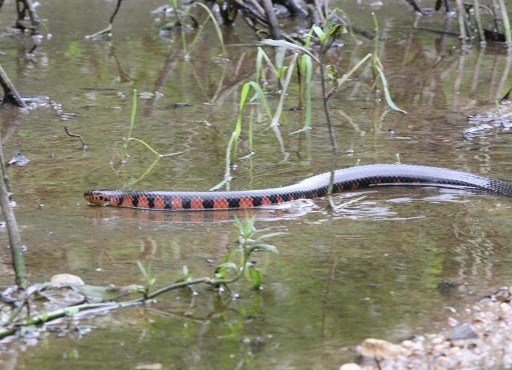
These days, civilisation has well and truly conquered Florida, whether it’s the sprawling cities of Miami and Tampa, or the razzle and dazzle of Disney World. Nevertheless, there are many untamed corners of the state still standing, where barely anything has changed for millions of years. There are countless eerie swamps which local people believe to be haunted, and one less known resident of those swamps is the mud snake.
This species also inhabits Georgia and Alabama, and co-exists with alligators, snapping turtles, cottonmouths and river otters. It’s obsessed with water, and though not fully aquatic, is nearly always found in close proximity to a swamp, small stream or pond. Mud snakes are mainly spotted by humans when crossing narrow rural roads, sometimes when the glare of headlights shines off their reflective scales.
Occasional people have had them slither through their garden fences, the unifying fact being that their houses were next to swamps. Mud snakes like not just swamps, but wooded, claustrophobic swamps covered with fallen logs and green vegetation. In other words, they like the exact kind of places where a thick mist forms on Halloween each year like clockwork.
| 2 | Buries itself in mud |
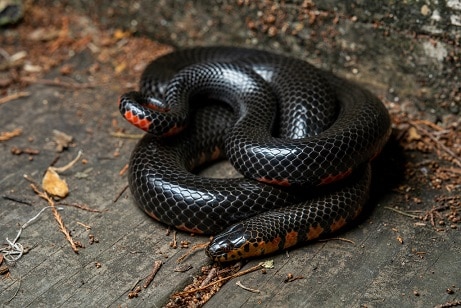
Mud snakes are superb swimmers, and during heavy downpours, they’ll often curl up beneath dense aquatic plants for shelter. When on land, mud snakes spend much of their time buried in thick mud, on the shores of their swamp hangouts. They can stay buried for hours if necessary, using their above average burrowing skills. With their shiny black scales, the disguise can be almost impenetrable. One mud snake observed in Florida had dug itself to a depth of 10 feet.
When heavy rains arrive in summer or fall, mud snakes suddenly flip and become much more adventurous. All they need is water sloshing around, and with the heavens opening, they can be found over 1000 metres from their swamp base.
Mud snakes also have an excellent sense of direction, as one individual studied in May 2018 travelled 322 metres away from its watery base. For one month, it settled into a narrow 10 metre radius, like an outpost away from home. Then in late June, it suddenly headed southwestwards again, travelling the full 322 metres back to its original swamp.
| 3 | Hoop snake rumours |
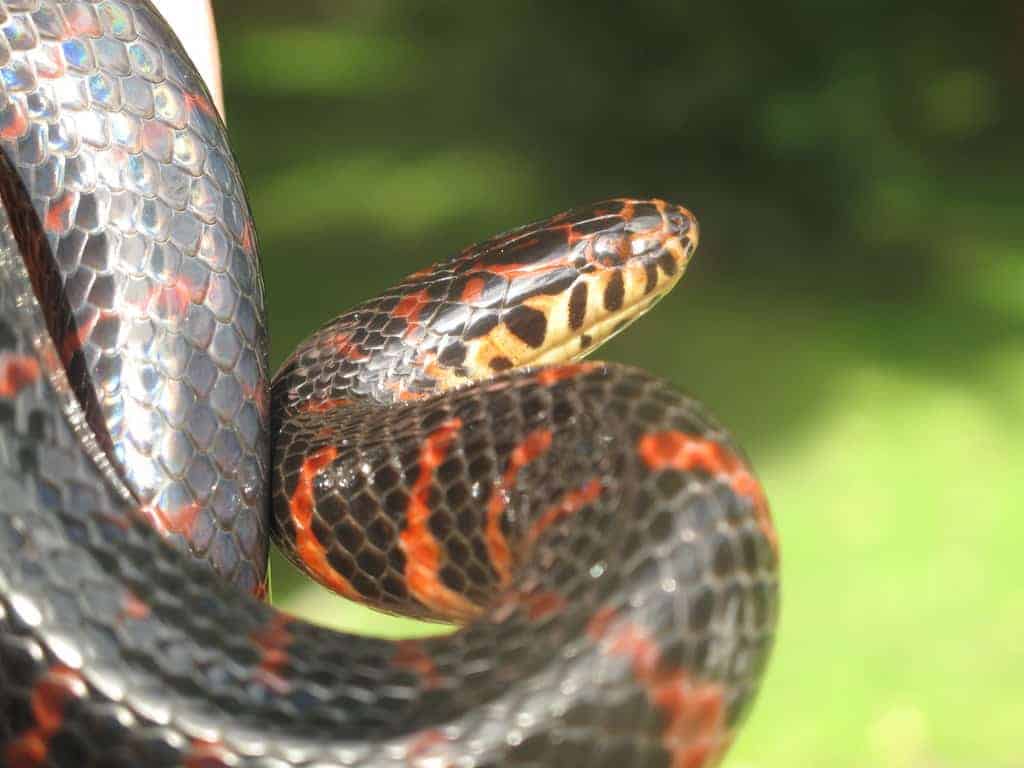
Alongside the coachwhip, the mud snake is one of the species believed to have inspired a classic American folklore character – the hoop snake. This legendary creature supposedly bites its own tail, forming a circle, which it then uses to roll towards innocent people at high speeds, for malicious reasons unknown. The mud snake version is that after finally catching up, the snake straightens out at the last minute, so that its sharp, pointy tail skewers the victim.
Mud snakes reportedly begin their rolls at the tops of hills, in order to pick up speed like a snowball. They’ll sometimes aim for a tree, and if the pointy tail penetrates deeply enough, then that proud tree will wither and die.
Many Louisiana old timers insist that these stories are true, sometimes pointing out the exact dead tree. This time, we know where the myth originated, as mud snakes have a habit of curling into a circle as they float on swamps. Numerous people have mistaken them for old car tyres when in this disguise.
| 4 | Gator dodgers |
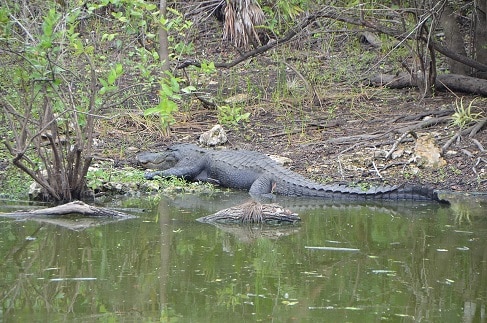
There are no southern swamps and waterways without alligators. These eternally smiling reptiles are able to eat most things, snakes included. Their blood contains antibodies which deactivate SMVP toxins, allowing them to eat even cottonmouths and rattlesnakes with no worries.
Consequently, the non-venomous mud snake is no problem, and this 2018 video from South Carolina showed one trapped in an alligator’s mouth, wrapped around its snout like a jumbo piece of spaghetti. For 2 minutes, the alligator eased forward, through a labyrinth-like swamp of fallen logs and boggy green vegetation. Most of the mud snake’s body was free, but the pointy tail, its main weapon, was clamped down and unable to move.
This wasn’t a rare occurrence, as mud snakes share much of their habitat with their distant reptilian cousin, and must be constantly on their guard. A pair of cunning yellow eyes poking above water is probably their worst nightmare. Occasionally though, mud snakes take advantage, and lay their eggs in alligator nests along riverbanks.
| 5 | Spikes enemies with its tail |
Farancia abacura has one of the most unique tails of American snakes. Over millions of years of hard toiling in swamps, they’ve successfully evolved a needle-like point right at the end, a hardened scale that sharpens into a great poking tool. They use this sharp tail like a rudimentary foot in the unstable mud, burying it a few centimetres deep and pushing forwards to give themselves momentum.
However, the main goal is self defence. When a greedy bird descends, the mud snake screws itself into a tight coil, with its head at the centre. This protects the brain, but leaves the tail free to deal out a painful poke, and scare the bird into messing with an easier snake instead.
This sharp tail has led to many nicknames, including stinging snake, stingaree, dart snake, and horn snake. For a while, it even led to a belief in a poisonous stringer. Juvenile mud snakes have the sharpest tails, whereas in adults, it’s blunter yet extremely hard.
| 6 | Completely and utterly harmless |
This razor sharp tail is also the only danger of picking mud snakes up out of curiosity. Mud snakes have a tendency to dig their tail into your palm and draw blood, in a small pinprick style wound. However, this isn’t usually an attack, but an attempt to gain purchase, like in their muddy abodes.
Mud snakes are completely non-aggressive towards humans, and have little fear of them either. Albert Wright was a respected herpetologist and author of Handbook of Snakes of the United States and Canada, and with his wife Anna (the book’s co-author), they captured a mud snake and brought it home. It wrapped snugly around their necks with no fuss, and their young daughter soon adopted it and made it the newest character in her collection of dolls. The snake seemed happy with its new life, and was in no rush to leave.
| 7 | Lays over 100 eggs |
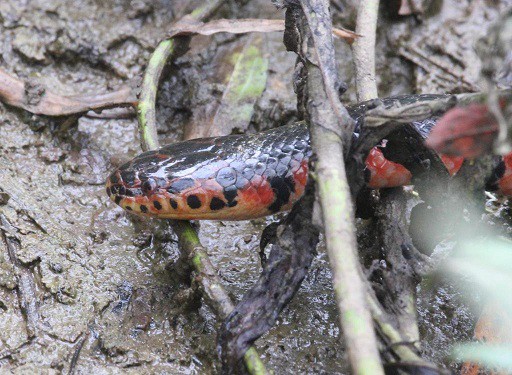
The endangered Louisiana pinesnake lays barely any eggs; just 4-5 boulder sized mammoths. Travel to the boggy, alligator-infested swamps of Florida, and you have the opposite end of the spectrum. The mud snake regularly lays over 100 eggs, one of the highest of any snake species. The hatchlings are also extremely small relative to adult body size (the smallest of the eastern US).
In 1929, a dead mud snake was found by a Florida highway. Inside its belly was 104 eggs, and this record stood until 2008, when a captive mud snake pumped out 119. 69 ultimately hatched, with 4 of the newborns being a rare anerythristic colour, with white bellies instead of red.
The range of the egg total is vast, varying from 4-119. It’s believed that the huge number is because of the endless predators they face, e.g. alligators with their crafty eyes, swooping hawks with their sharp talons. The African puff adder is a close rival, producing up to 156 newborns, but those are born live rather than in eggs.
| 8 | Diet: enjoys slimy amphibians |
Mud snakes have unusually large rear teeth for a non-venomous snake, and the reason is to grip their main foodstuff: amphibians. The mud snake isn’t an unfussy eater like the cottonmouth, nor a lizard eater like the eastern coral snake. It sticks to slippery, watery creatures instead, including three-toed amphiuma (which looks like a snake itself), greater sirens, mole salamanders and tadpoles.
Mud snakes are so dedicated to team amphibian that they often starve themselves to death rather than eat anything else. The only solution captive breeders have found is to rub other animals with a natural amphibian scent.
In contrast to their calm ways with people, mud snakes can be savage hunters. When a three-toed amphiuma flees, a mud snake will charge after them in hot pursuit, across the muddy flats and into their dark burrows. Their pointy tail comes in handy for skewering these slimy amphibians – it’s believed that this was why the spiky tail evolved, with bird defence being a nice bonus.
| 9 | Identify the mud snake |
They may lack venom, but mud snakes beat the Florida snake pack for what’s really important – shininess. Their back scales are smooth with a metallic sheen, and almost completely black. Their belly is a deep orange to red, extending up the sides and just reaching the head. Newborns have the exact same colour scheme, just with the red covering more area.
Spotting these snakes is a piece of cake – they look like a volcanic eruption at the dead of night, similarly to Australia’s red-bellied black snake. The one exception is a small population in central northern Florida, where the bellies are white instead. Even their eyes stick to this colour scheme, as their pupils are black and their irises red. The eyes themselves are particularly small and beady.
Mud snakes are a medium species, ranging from 90 to 120cm, with the record being 2 metres. Nobody has ever lived in Florida’s swamps 24/7 (well, maybe a few hermits), and longer mud snakes in years gone by are certainly possible.
| 10 | Comparison: black swamp snake |
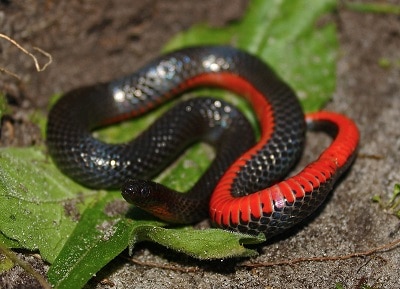
Identifying a mud snake is probably a 3/10 on the difficulty scale. They’re not a member of Florida’s nursery rhyme club, the crew featuring eastern coral snakes, Florida kingsnakes and scarlet snakes, where the key lies in the positioning of yellow, red and black bands. Mud snakes are far too black to be confused with those guys, but instead, there’s the black swamp snake.
This non-venomous constrictor has a near identical black-red colour scheme, with equally sharp contrasts like a fire in darkness. They even share the same swampy, well-vegetated habitats, with cypress swamps being a hotspot for both.
The ultimate key to ID expertise is that black swamp snakes have the red far more restricted to their bellies. With mud snakes, the red patterns spread upward in a more disordered way. At an immediate glance, the black swamp snake looks far blacker.
The other ID key is that black swamp snakes are much smaller. They average at 23-38cm, compared with the mud snake’s 1 metre plus.
| 11 | The Farancia snake clan |
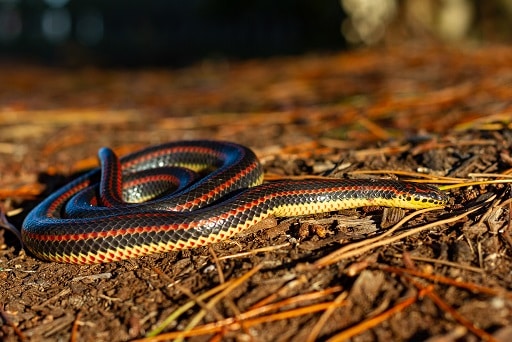
While Florida is the mud snake’s heartland, the species inhabits a total of 15 US states. Their westernmost point is eastern Texas, stretching well beyond Houston and reaching Copus Christi. To the north, they reach southern Virginia. Some of their heavy states include Georgia, North and South Carolina, Mississippi, Alabama, Louisiana, and Arkansas. They also have small presences in western Tennessee, southeast Oklahoma, and the tristate area of Missouri, Kentucky and Indiana. A 16th possibility is Indiana: mud snakes were known from one swamp in the extreme south, but were recorded only in the mid-1900s, and that swampland has now been drained.
Across these lands, seek a swamp, and the mud snake ye may find. The mud snake’s Farancia family has just 1 other member: the rainbow snake (Farancia erytrogramma). This also inhabits swamps, and is a similar length at 90-120cm, but is easily distinguishable, with far more extravagant colours. Rainbow snakes overlap with mud snakes in their territory, occupying Florida, Georgia, and the Carolinas.
Outside their genus, the mud snake’s closest relative is the sharp-tailed snake (Contia tenuis) of the western US, which measures just 30cm, and the recently discovered forest sharp-tailed snake. This is among 3900 snake species worldwide.
